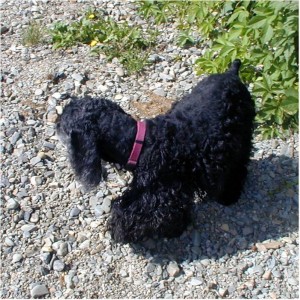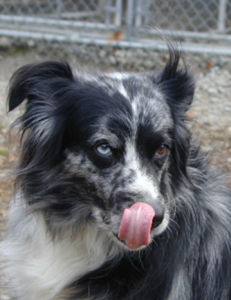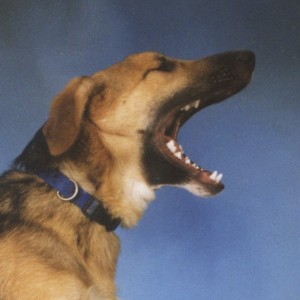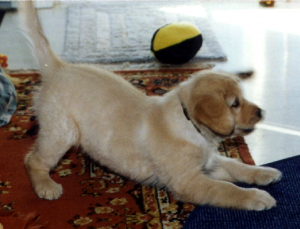This material is from Best Friends for Life by Don Hanson>
Even though dogs do not ‘talk’ in the same way that we do, they do manage to communicate with other dogs’ quite well. Dogs use some forms of vocal communication (whine, bark, growl, howl, etc.) as well as a variety of body postures and movements to indicate their messages. Puppies learn these communication skills while with their litter and mother. Puppies separated from their litter before eight weeks of age run the risk of not having enough exposure to this process and may exhibit behavioral problems.
If you spend some time learning canine as a second language, you will be rewarded with a much better understanding of your pet and his behavior. With study and practice, you can learn to understand what your dog is trying to communicate.
Vocal Communication
Barking, whining and growling are all means of vocal communication. Whining is an indication of stress or anxiety. A dog may whine when he is doing something that he dislikes or that frightens him. Punishing a dog for whining will only make the problem worse. You need to determine the cause of the stress and find a way to remove it.
Growling can take two different forms. A ‘play’ growl can be heard when dogs are engaged in roughhousing or mock fighting. It is usually low and rumbly, but soft. A warning growl is different. This dog means business. A warning growl usually increases in volume as it continues and is accompanied by a menacing body posture (this will be discussed further below).
Never punish your dog for growling. A growl is a very useful warning signal. A dog that is punished for growling will stop the growling but it will not remove the reason for the growl. A dog that no longer growls, no longer gives a warning before taking more drastic action. As a trainer who sometimes deals with aggressive dogs, I much prefer a dog that gives me a warning.
Certain breeds of dogs are more prone to barking than are others. A bark can convey many different kinds of information. If you listen closely, you can probably tell an “I’m bored” bark from a “somebody is at the door!” bark. Some dogs are recreational barkers and just love to hear the sound of their own voices. They bark and bark and bark. Since this behavior is self-reinforcing, it can be difficult to deal with.
People have gone to extremes to remedy a barking problem, everything from electronic shock collars to having the dog’s vocal cords cut. However, even these extreme methods do not stop many dogs and do not change the dogs emotional state which is often one of anxiety and fear. While a shock collar or removal of the dogs vocal cords may make us feel better, it usually makes the dog feel worse.
Barking is a very complex behavior. If you have a barking problem, I suggest you work with a qualified trainer or behaviorist.
Body Language
While dogs do vocalize, most of their communication with one another, and even us, is done through their body language. Canine body language is very subtle, yet also very sophisticated. Research by Dr. Patricia McConnell has indicated that “Important signals may last only a tenth of a second and be no bigger than a quarter of an inch.” For Example: Leaning forward ½ an inch can stop a dog from coming while leaning back ½ an inch encourages the dog to come.
Dogs manage to convey an enormous amount of information by small changes in posture and demeanor. For example, many people believe that a wagging tail signals a happy dog. If the tail is low and relaxed, this is probably true. However, if the tail is held high and is quickly switching back and forth, the dog is signaling agitation or the possible intention to attack. In addition to the tail, there are other cues such as whether or not the hackles (hair along the back of the neck) are raised. This little trick actually serves to make the dog look bigger and more frightening, and usually occurs when the dog feels threatened. However, the hackles may simply be up because the dog is in a high state of arousal or excitement. We often see this when dogs are simply playing.
Other signs of aggression can include a dog that takes a stance with most of its weight over its front legs, almost leaning forward on its toes. Ears may be back or up, depending upon the breed. Along with a low growl, the dog may snarl and show teeth. A dog that intends to attack will probably stare hard at its victim.
A submissive dog, displays a whole different set of postures. The submissive dog will keep its head down, and may lower itself to the ground. A really submissive dog may go ‘belly up’ or urinate when approached. These are indications that the dog is trying to avoid conflict and does not want to fight. The submissive dog will not usually look directly into your eyes. A dog that has panicked and is very frightened may stare at you.
Aside from tail wagging, a happy dog usually displays other signs. Some even go beyond tail wagging to whole body wagging! A happy dog’s mouth is usually slightly open and relaxed. They often look as though they are laughing. The entire body seems at ease when the dog is happy.
When two dogs are together, people often have a hard time telling whether the dogs intend to play or fight. One sure sign of intention to play is a play bow. In a play bow, the dog rests its front legs and chest on the ground and leaves its hindquarters in the air. This is accompanied by frenzied tail wagging and jumping from side to side. A play bow is an invitation to romp. Try getting a play bow from your dog by getting down on the floor and doing one first.
Dogs who intend to fight have a much stiffer body posture and their movements are sharper and more deliberate.
Verbal versus Visual Communication
When you bring your pet to us for boarding or grooming, you let us know your pet’s needs and requirements by talking to us. As humans, our primary method of communicating with one another is the spoken word. More simply, we make noises that other humans are able to understand. People are so accustomed to communicating with our own species by talking, that we presume it is the most efficient method of communicating with other species such as our dogs. That is not the case.
While our dogs offer many vocalizations (barking, whining, howling, etc.) their primary method of communicating with one another and with us is visual. They observe body language. When with one another they look at how they stand, what they do with their tails, ears, eyes, and lips. This is why most dogs will learn a hand signal easier and quicker than they learn a verbal cue for a behavior.
To demonstrate this, Dr. Patricia McConnell, a canine behaviorist at the University of Wisconsin, conducted a simple experiment. She selected 24 puppies, six and a half weeks old, four each from litters of Australian Shepherds, Beagles, Border Collies, Dalmatians, Cavalier King Charles Spaniels, and Miniature Schnauzers. She and her graduate students then spent four days training the puppies to “sit” upon presentation of both an audible and a visual signal. The trainer presented a sound at the same time they scooped their hand up over the puppy’s head. On the fifth day the trainers presented the puppies with one signal at a time so they could determine whether the audible or visual signal resulted in more correct responses. Twenty-three of the 24 puppies responded better to the visual signal than the sound. One of the puppies responded equally well to both. Eight of the puppies did not respond to the audible signal at all. The following table indicates correct responses to audible and visual signals by breed.
| BREED | VISUAL | AUDIBLE |
| Australian Shepherd | 92.5% | 15% |
| Beagle | 80% | 0% |
| Border Collie | 92.5% | 15% |
| Cavalier King Charles Spaniel | 90% | 50% |
| Dalmatian | 80% | 20% |
| Min. Schnauzer | 80% | 0% |
This simple study suggests that when training our dogs we can make it easier for them and ourselves by teaching a visual cue first.
We also need to be aware of everything we are doing with our bodies when training our dogs. Just because we think the visual cue for sit is scooping our hands, does NOT mean that is what the dog is really cueing on. For example, one year one of our students commented his dog was inconsistently responding to a visual cue for sit. After watching them for a few exercises I quickly determined the problem. While the student usually scooped his hand for a sit, occasionally he would scoop his hand and then rest his hand on his stomach. The dog sat every time the student scooped and then rested his hand on his stomach. The dog had a visual cue for SIT; it just was not the cue the student intended.
Spend some time watching your dog interact with you and other living things. The better you learn their language, the happier you both can be.
Calming Signals
When dogs interact with one another and with us, they often use body language to cutoff perceived aggression or other threats. Turid Rugaas, a canine behaviorist from Norway, calls this type of body language “Calming Signals.” These signals are used to prevent aggression, and for calming down nervousness in others. Dogs use these signals to communicate with one another, us, and even other species of animals. They are a dog’s primary method of resolving a potential conflict.
By learning, understanding and using these calming signals, you can communicate better with your dog. I have outlined some of these calming signals below. If you would like to learn more about them, I suggest you read Ms. Rugaas’ book, On Talking Terms With Dogs: Calming Signals and watch her video, Calming Signals: What Your Dog Tells You.
Averting the Eyes

Breaking eye contact, by averting the eyes is often the first sign of stress observed in a dog.
Turning of the Head

If your dog becomes nervous about the approach of another dog or person, he may turn his head from side-to-side, or may just turn away. This signals the other dog that they are approaching too quickly or too directly.
Turning Away

This is an extension of turning your head. If a group of dogs are playing and some of them get too rough, other dogs may turn their side or back to them in order to get the dogs settled down. We often saw this behavior with our dogs when playing. If our Border collieX Shed felt play was “getting too wild,” she would turn away from the other dogs. If your dog is jumping or whining at you, turning away from them may help calm them.
Nose Licking

Rapid flicking of the tongue over the nose is also a common calming signal. It is often seen with dogs at the veterinarians or when the dog is at the groomers.
Sniffing

Sniffing as a calming signal must be reviewed within the context in which it appears. Obviously, dogs sniff for other reasons than to just indicate stress.
Yawning

Dogs may yawn when in stressful situations such as at the vet’s office or during a quarrel among its family. If your dog is feeling stressed, standing still and yawning may help them relax. They need to see you yawn though, so even though it is impolite, you do not want to cover your mouth if this is to work.
Play Position

Dogs will use a “play bow” (front legs and chest on the ground with hind quarters in the air) to initiate play or to calm another animal down that they are unsure about. You can do a play bow to initiate play or to help relax a dog.
You can learn much about your dog by just sitting back and watching them interact with you, other family members, other dogs and other animals. If you spend the time to do this, it will greatly increase your ability to communicate with your dog
Distance Increasing Signals
These signals are meant to increase the distance between two individuals. They are a way of saying “you are invading my comfort zone” and by paying attention to them, one is often able to avoid being bitten. These signals are:
Tooth Displays
Whale Eye
“Hard Eyes”
Body weight forward
Ears forward
Tense body/face
Head/Neck is lowered
Increase in Height
Intense Barking
Tail up high, “flagging”
Freezing in Place
Hackles Up (Piloerection)
Mouth Closed
Urine marking
How We Communicate With Our Dogs – Dog Handling Skills
Just as you can learn a great deal from your dog’s body language, your dog reads a lot about you from your body language. Some body language you can use to your advantage is:
Do not bend over your dog. Squat next to them or stand straight. When you bend over the dog, you are putting them in a defensive position.
When training the recall, stand straight or squat with your arms outstretched. Stooping over the dog will cause him to avoid you.
Smile. Your face says a great deal about your attitude.
When petting a dog for the first time, touch them on the sides of their body and on their chest. Never pat them on the top of the head.
Avoid hugging your dog. No matter how much pleasure you get from hugs, your dog does not enjoy it.
Recommended Resources
Books
On Talking Terms With Dogs: Calming Signals, Turid Rugaas, Dogwise Publishing, 2006
Calming Signals: What Your Dog Tells You – DVD – Turid Rugaas,
The Other End of the Leash – Why We Do What We Do Around Dogs, Patricia B. McConnell, Ph.D, Ballantine Books, 2002
Stress in Dogs, Martina Scholz and Clarissa von Reinhardt, Dogwise Publishing, 2007
The Language of Dogs – Understanding Canine Body Language and Other Signals- DVD’s – Sarah Kalnajs, Blue Dog Training and Behavior, 2006
OFF-LEASH Dog Play, Robin Bennett, CPDT and Susan Briggs, CKO, C&R Publishing, 2008
YouTube
Turid Rugaas Calming Signals DVD – http://www.youtube.com/watch?v=Lj7BWxC6iVs
©2015, Donald J. Hanson, All Rights Reserved <Click for Copyright and Use Policy>